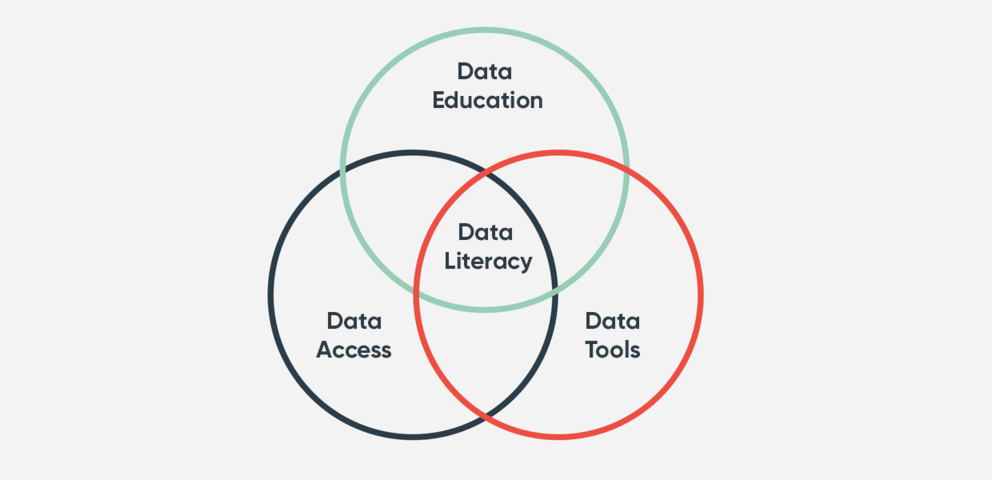The goal: to gain best possible insights into companies and markets. For example, to improve products and services, increase operational efficiency or better understand your own customers.
With Business Intelligence & Analytics: Faster and smarter than everyone else.

Data Literacy
What value does data hold if business users lack access or the ability to analyze it with the appropriate tools? None at all, right? Nothing at all! And precisely this data competence is becoming increasingly important in the course of digital transformation. In short, know where to get the data and how to analyse it.
Data literacy is made up of many individual skills that can be divided into different categories. Depending on the concept, the number and naming of these categories can differ. Typical categories are for example: Data Collection, Data Management, Data Analysis, Data Understanding and Interpretation, Data Presentation and Data Application.
Data Governance
Who is responsible for data security in a company? Who has access to which data? This is exactly what needs to be determined.
We develop these processes and responsibilities together with you. Data governance is the keyword and includes the collection of processes, roles, policies, standards and metrics that ensure the effective and efficient use of information to achieve goals. A well-established data governance strategy is not just an option for any company dealing with data; it's a necessity.
Data Management & Data Integration
Generally, includes the various actions companies take to manage data throughout its lifecycle. This includes Data Management, Data Integration and Data Quality efforts.
For Data Management, for example, policy-driven standards (data governance) help ensure that data is formatted correctly for use in a business system. Data Integration, on the other hand, describes the combination of data from different sources and their uniform presentation. One focus here is the creation of a central analysis platform in which all different types of data from different sources are stored. Effective Data Quality maintenance requires regular data monitoring and cleansing. In general, Data Quality maintenance involves updating/standardizing data and duplicating records to create a unified data view.
However, as is the case with many areas, the proper interaction of all factors is crucial here.
Data Warehouse
In summary, a data warehouse is a central database in which data from various sources is collected, condensed and stored for the long term. Building a data warehouse in the company is complex and time-consuming to maintain.
Our approach is no longer to build DWHs monolithically and waterfall-like over several years, but to create them successively and agilely. Data and use cases are incorporated gradually instead of creating an overall solution.
Once a Data Warehouse has established itself in the company, many challenges arise regarding:
- Scaling (Growth with number of data)
- Access (Hundreds of users)
- Security (Which data can be seen by whom?)
- Data Maintenance (Data Quality)
- History (How to deal with old data)
- Versioning (What if the structure of the DWH changes?)
From Data Warehouse to Data Lake. A weakness of the Data Warehouse is that it focuses mainly on the procurement and provision of structured data. In the big data environment, however, it is necessary to access a large amount of information, which is often only available in unstructured form. This challenge has resulted in the complementary concept of the Data Lake. The Data Warehouse can be expanded to a big data analytics platform using the data lake. Our experts support you in identifying these challenges early on and implementing them in a holistic strategy.
Data Lake
Flexible analyses despite or thanks to huge amounts of information! The data originating from various sources can be used for the most diverse applications and analyses. In addition to text- or number-based data, the Data Lake can also take into account images or videos. Structuring and, if required, reformatting of the data concerned only takes place when the data is actually needed.
However, although Data Lakes are suitable for storing data, they lack some important functions. For instance, they do not support transactions and their lack of consistency/isolation makes it almost impossible to mix attachments and reads as well as batch and streaming jobs.
The solution: Data Warehouse x Data Lake = Data Lakehouse. A lakehouse is a new, open architecture that combines the best elements of data lakes and data warehouses in one system. The result: data teams can work faster and more efficiently.
We rely on the following solutions: First, the Databricks Lakehouse platform. This has the architectural features of a Lakehouse - but at lower cost and with more flexibility. Microsoft's Azure Synapse Analytics, on the other hand, integrates with Azure Databricks and optimally combines the areas of data integration, Big Data analyses and data warehousing at enterprise level.
Advanced Analytics
Thanks to highly developed technologies, analyses with Advanced Analytics go far beyond the applications of traditional Business Intelligence (BI). The goal: to gain deeper insights, make better predictions or derive more concrete recommendations for action.
The applied analysis techniques include data/text mining, machine learning, pattern matching, forecasting, semantic analysis, sentiment analysis, network & cluster analysis, graph analysis, simulation, complex event processing and neural networks. Secure your competitive advantage now and work with us to achieve the consistent use of advanced analytics to make business-critical processes more efficient. For example: The development of predictive forecasting models for forecasting financial flows (e.g., cash flow forecast).
Self Service BI
What is driving the need for Self Service BI in the business departments? Obviously, a lack of agility in the supply of information as well as ever-increasing demands for ad-hoc evaluations.
The solution: self-service BI combined with a mature data governance strategy. Because Self Service BI involves the risk of generating larger data sources, definitions and isolated solutions in an uncontrolled manner. A mature data governance strategy counteracts this and forms the necessary framework for a functioning managed self-service approach. Together with you, we implement modern self-service platforms and architectures that are managed independently in your specialist departments and thus ensure greater independence from IT.
Reporting & Visualisation
Good decisions require that they are based on the right information. It can be fatal for a company if decision-makers misunderstand information from reporting. The basis for comprehensible reporting must therefore be the introduction of a visualisation standard.
Based on the IBCS standard, we develop report notations with our customers that enable you and your employees to create meaningful and understandable reports. Another positive effect of developing and introducing a visualisation standard: the amount of reports can be reduced by up to 80%.
